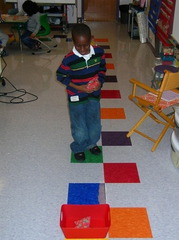Phonemes, “the smallest unit of speech
sounds that makes a difference in communication”, are an important part of
phonemic awareness (Yopp & Yopp, p. 2, 2000). Because my cousin is entering
kindergarten, I decided to test his ability to hear phonemes.
The Yopp and Yopp (2000) article, Supporting phonemic awareness development in the classroom, did a nice job of defining
phonemic awareness as “the awareness that spoken language consists of a
sequence of phonemes”. Both this article and the Clark (2004) article, What can I say article but "sound it out?" Coaching word recognition in beginning readers, discussed the importance of incorporating differentiated instruction when cuing
the children in one's classroom. Having children learn though a combination on
oral, auditory, reflective, or kinesthetic cues enhances their learning and
provides an universally designed lesson where each child is given the best
environment for them to learn. Both articles gave examples of how to further
phonemic awareness through cuing and coaching. Ultimately, coaching is using
cues to enhance a child's knowledge.
Having read these articles, I felt
prepared to assess my cousin’s phonemic awareness. To begin, I asked him to say
his name. He replied with “Steven”. I then went on to explain that is name was
made up of 6 letters. This perplexed him because he has only recently learned
his ABC’s and how to write his name. He sees the alphabet as one whole entity
and his name as a whole separate entity. There appeared to be no relation
between the two. I made manipulatives of letters and placed the “s” in front of
him. He knew it was an “s”, but did not grasp it was a letter without the rest
of the alphabet beside it. I then said “s” makes a “sssss” sound like in the
word snake. I then placed a “t” beside the “s” and told him that an “s” and a
“t” beside one another make the “st” sound like in the word star. This was
highly confusing. Because of this, I altered my approach to just single letters
by themselves. I used the handout from class “Beginning Blends and Digraphs” to
guide my approach. I made my own cards with a letter, a picture that started
with that letter, and the picture spelled out. I took the “s” and asked him
what sound his name started with. He stated it started with the letter “s”. I
told him he was right, but that the letter “s” made a sound, and I wanted to
know what sound that was. He looked at me blankly. I started to say his name,
but I dwelled on the “s” to emphasis its sound. This seemed to make sense. I
again pointed to the “s” card and asked what sound does a “s” make? He said “ssss”.
Yes! Now we were finally getting somewhere. We then tackled the “t”, so I felt
it was time to review the “s” sound. He couldn’t remember. I told him the “s”
makes the same sound as the beginning of his name, but he went right back to
saying his name started with the letter “s”. I reminded him that we were focusing on sounds
not letters and then said his name again putting emphasis on the “s”. That
helped him remember that “s” makes a “ssss” sound.
After only two letters, he was exhausted and so
was I. I let his mother watch us while we learned the “t” so that she could see
how to help him learn letter sounds. I also left her the manipulative cards I
had created. With practice, Steven will learn that words are made up of
individual sounds and that each sound corresponds to a letter or a set of
letters. Knowing that he is capable of comprehending phonemes and seeing him
exposed to phonemes and phonemic awareness was encouraging.
This is similar to what I did on each of his cards. I placed one letter and one picture so that he could say the word and hear the beginning phoneme.








